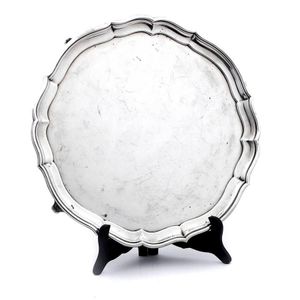Scalloped Silver Waiter with Engraved Armorial, 1964
You must be a subscriber, and be logged in to view price and dealer details.
Subscribe Now to view actual auction price for this item
When you subscribe, you have the option of setting the currency in which to display prices to $Au, $US, $NZ or Stg.
- Engraving - The method of decorating or creating inscriptions on silver and other metal objects by marking the surface with a sharp instrument such as a diamond point or rotating cutting wheel.
- Armorial / Armourial - Bearing a coat of arms. Coats of arms came into general use by feudal lords and knights in in the 12th century, and by the 13th century, arms had spread beyond their initial battlefield use to become a flag or emblem for families in the higher social classes of Europe. They were inherited from one generation to the next. When a family crest is used on individual items of silver or furniture it is an indicator of the aristocratic standing of the family represented.
Armorials were also used to decorate mass produced ceramic souvenir ware by such companies as Goss, Carlton & Shelley, and in these cases the coats of arms displayed were of boroughs and cities. - Scallop / Shell Motif - The shell motif has been used in furniture and decorative arts for centuries. In ancient Greece and Rome, shells were often used as decorative elements on furniture and in mosaics. The scallop or cockleshell are the most commonly used. During the Renaissance, the shell motif became popular in furniture and architecture, as the ornate decoration was seen as a symbol of wealth and luxury. In the 18th century, the Rococo style of furniture and decorative arts featured an abundance of shell motifs, and it was used by Thomas Chippendale and as a feature on Queen Anne style cabriole legs. In the 19th century, the shell motif was incorporated into Victorian furniture and decorative items, and often a representation of the the conch shell was inlaid into furniture.
This item has been included into following indexes:
Visually similar items

English hallmarked sterling silver George II salver having an applied shell form Chippendale border, a plain ground, sitting on three cast hoof feet. Condition good, some tarnishing, some possible restoration. London, 1742, maker I.C. Diameter 16 cm. Weigh

A silver tray, circular form, scalloped ribbed edge, footed base; Viner's Ltd (Emile Viner), Sheffield, 1957. Diameter 24.5 cm. Weight: 520g.

A George VI sterling silver circular salver by Elkington & Co, 1939, 35 cm diameter 1185grams

An Australia 9ct gold photograph pendant locket with pearl-set border; Willis
